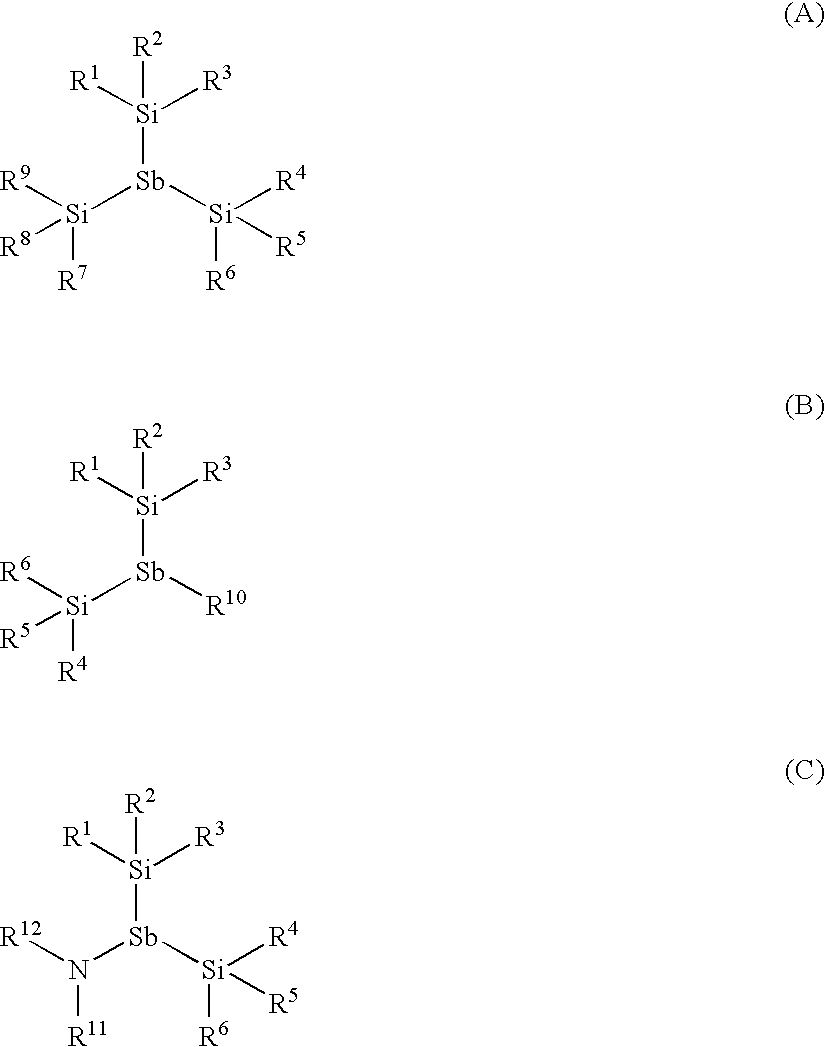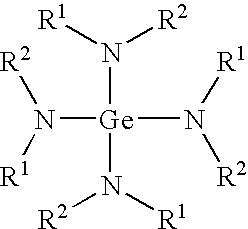Antimony Precursors for GST Films in ALD/CVD Processes
a technology of antimony precursors and ald/cvd processes, which is applied in the direction of antimony compounds, group 5/15 element organic compounds, and silica compounds, etc., can solve the problem of high reset current level that must be applied
- Summary
- Abstract
- Description
- Claims
- Application Information
AI Technical Summary
Benefits of technology
Problems solved by technology
Method used
Image
Examples
example 1
Synthesis of Tris(trimethylsilyl)antimony
[0042]1.22 g (0.01 mol) of 200 mesh antimony powder, 0.72 g (0.03 mol) of lithium hydride, and 40 ml of tetrahydrofuran (THF) were placed in a 100 ml flask. With stirring, the mixture was refluxed for 4 hours. All of the black powder constituting antimony disappeared, and a muddy colored precipitate was formed. Then, the mixture was cooled down to −20° C.; 3.3 g (0.03 mol) of trimethylchlorosilane was added. The mixture was allowed to warm up to room temperature. After stirring for 4 hours, the mixture was filtered under inert atmosphere. The solvent was removed by distillation. Tris(trimethylsilyl)antimony was purified by vacuum distillation.
example 2
Synthesis of Tris(dimethylsilyl)antimony
[0043]1.22 g (0.01 mol) of 200 mesh antimony powder, 0.72 g (0.03 mol) of lithium hydride, and 40 ml of tetrahydrofuran (THF) were placed in a 100 ml flask. With stirring, the mixture was refluxed for 4 hours. All of the black powder constituting antimony disappeared, and a muddy colored precipitate was formed. Then, the mixture was cooled down to −20° C.; 2.83 g (0.03 mol) of diimethylchlorosilane was added. The mixture was allowed to warm up to room temperature. After stirring for 4 hours, the mixture was filtered under inert atmosphere. The solvent was removed by distillation. Tris(dimethylsilyl)antimony was purified by vacuum distillation.
example 3
Synthesis of Tris(dimethylsilyl)antimony
[0044]3.65 g (0.03 mol) of 200 mesh antimony powder, 2.07 g (0.09 mol) of sodium, 1.15 g (0.009 mol) of naphthalene, and 50 ml of THF were placed in a 100 ml flask. The mixture was stirred at room temperature for 24 hours. All of the black powder constituting antimony and sodium disappeared, and a muddy colored precipitate was formed. Then, the mixture was cooled down to −20° C.; 8.51 g (0.09 mol) of dimethylchlorosilane was added. The mixture was allowed to warm up to room temperature. After stirring for 4 hours, the mixture was filtered under inert atmosphere. The solvent was removed by distillation. Tris(dimethylsilyl)antimony was purified by vacuum distillation.
PUM
| Property | Measurement | Unit |
|---|---|---|
| temperature | aaaaa | aaaaa |
| temperature | aaaaa | aaaaa |
| general structure | aaaaa | aaaaa |
Abstract
Description
Claims
Application Information
 Login to View More
Login to View More - R&D
- Intellectual Property
- Life Sciences
- Materials
- Tech Scout
- Unparalleled Data Quality
- Higher Quality Content
- 60% Fewer Hallucinations
Browse by: Latest US Patents, China's latest patents, Technical Efficacy Thesaurus, Application Domain, Technology Topic, Popular Technical Reports.
© 2025 PatSnap. All rights reserved.Legal|Privacy policy|Modern Slavery Act Transparency Statement|Sitemap|About US| Contact US: help@patsnap.com



